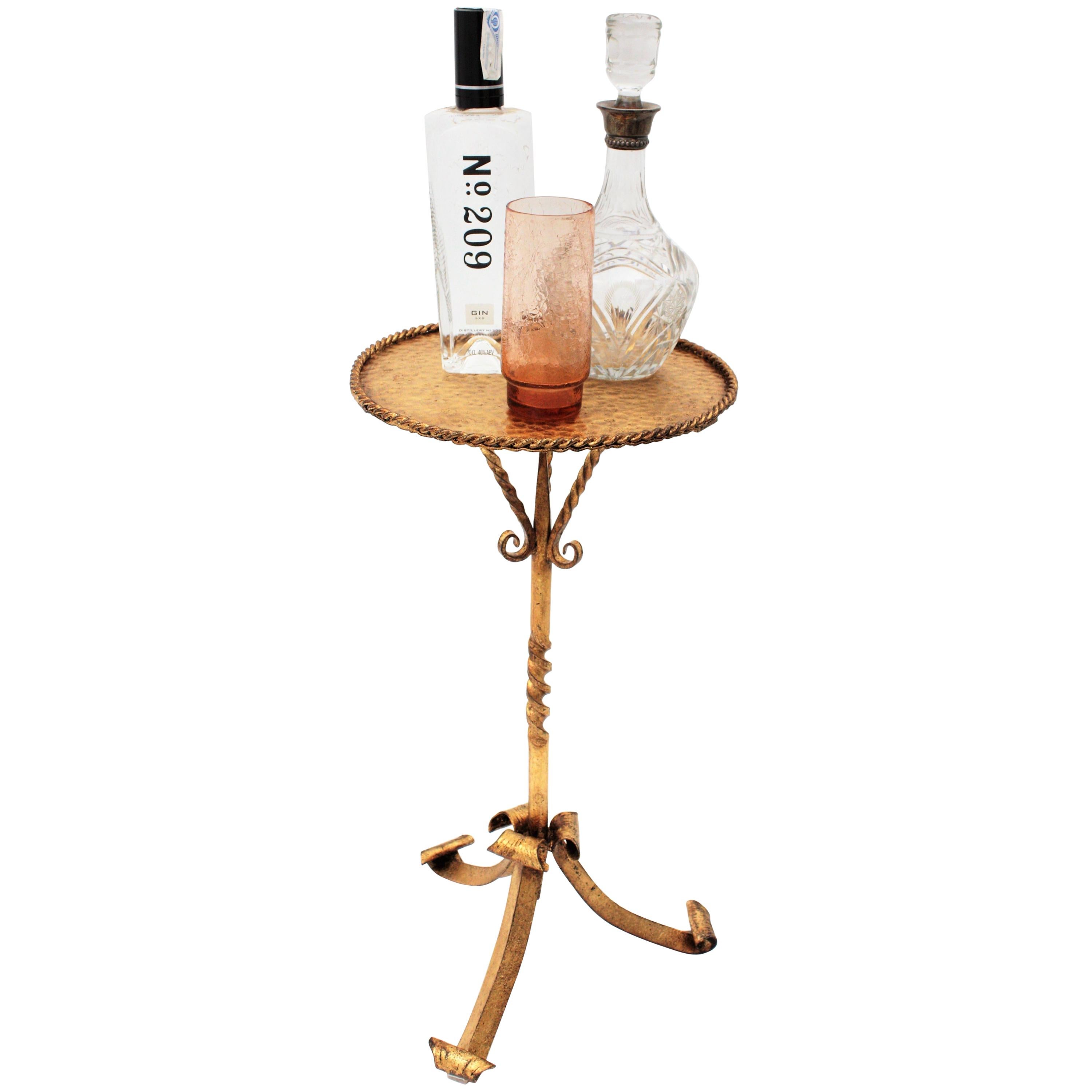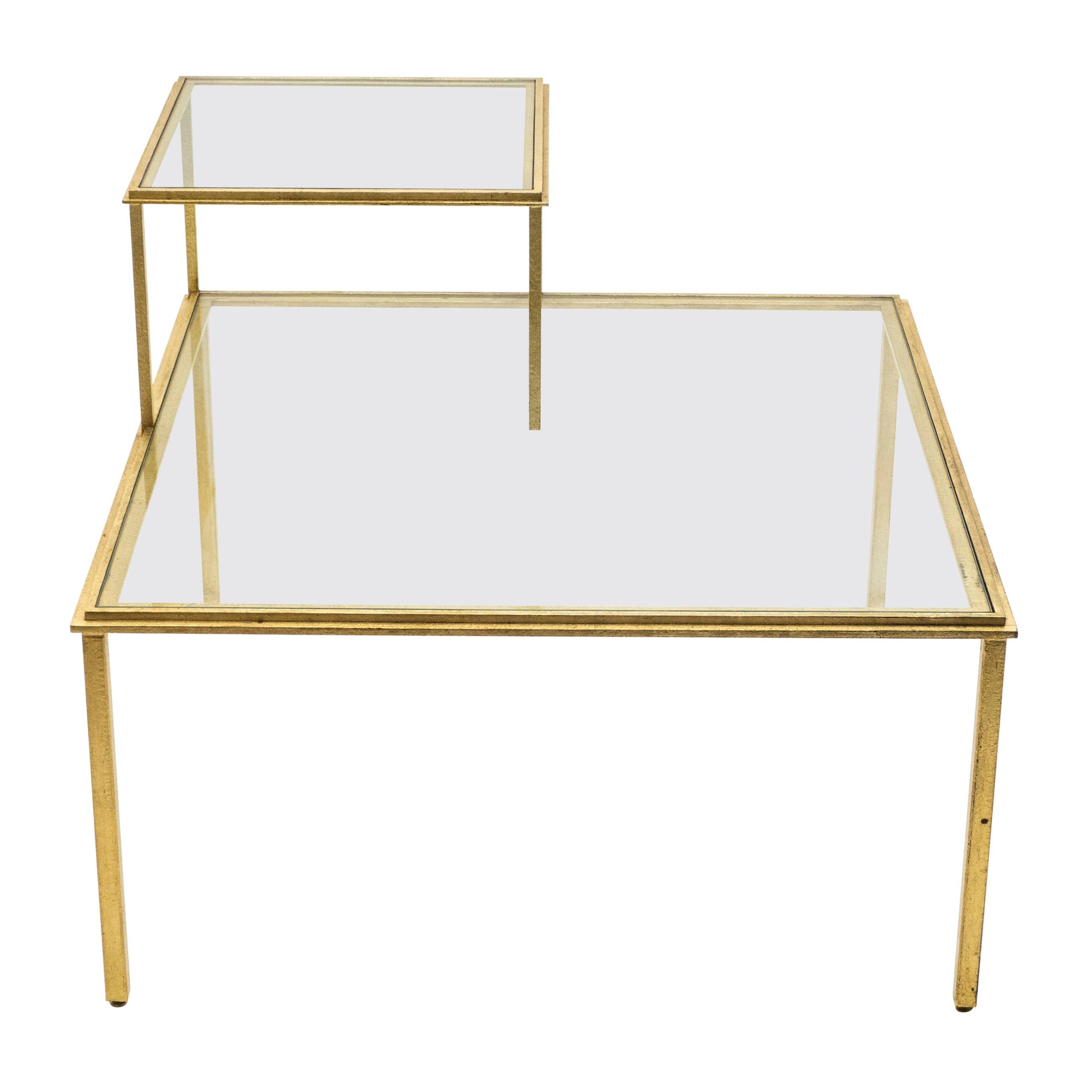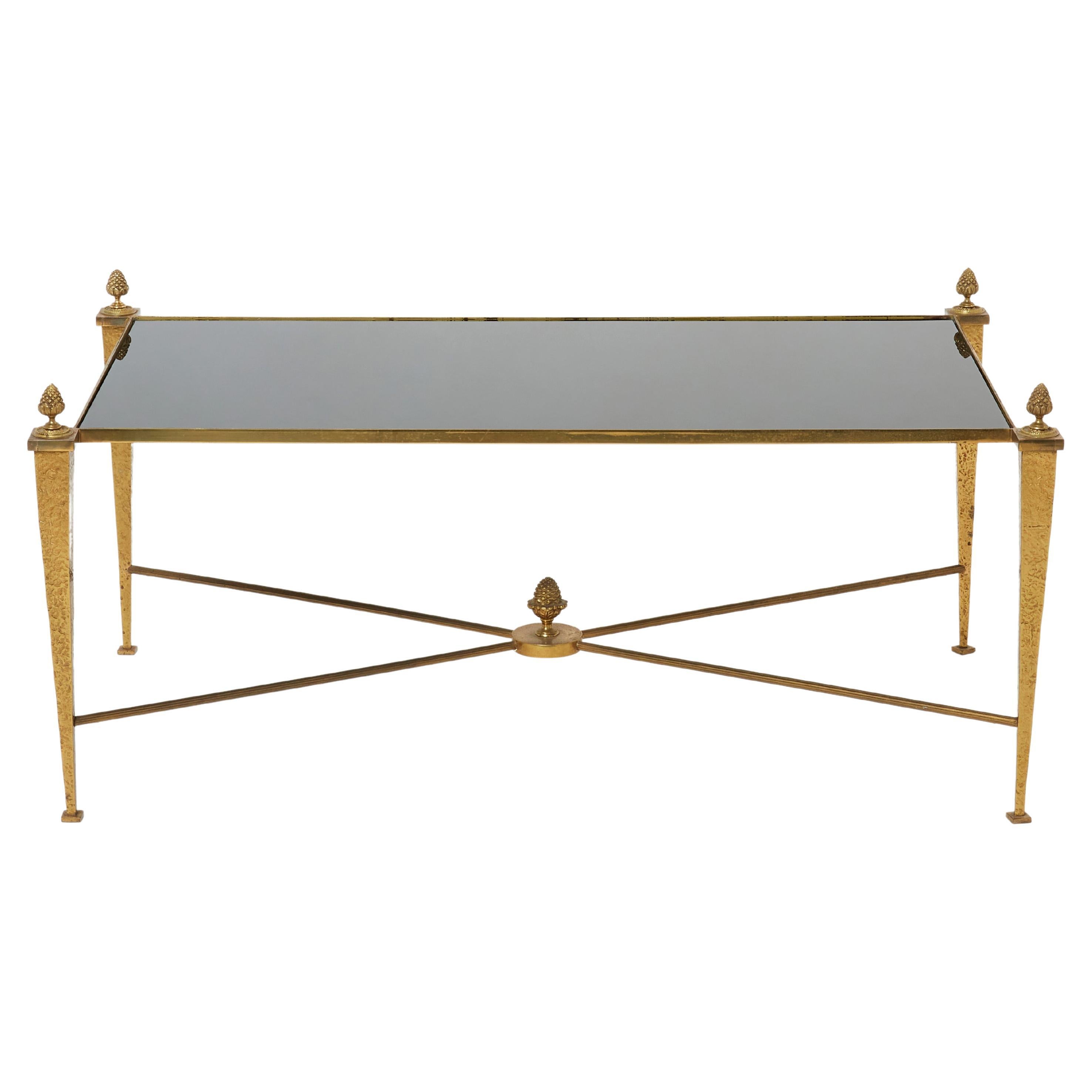Items Similar to André Kulesza Architect. Unique Light Table, Wrought Iron, Glass Crystals 1960s
Video Loading
Want more images or videos?
Request additional images or videos from the seller
1 of 22
André Kulesza Architect. Unique Light Table, Wrought Iron, Glass Crystals 1960s
About the Item
Exceptional light coffee table by the architect André Kulesza, hammered wrought iron and polychrome stained glass crystals.
The fragments of glass crystals have been carefully selected and combined harmoniously to represent an abstract design.
The glass crystals are fixed on reinforced glass and protected by a window which acts as a table top.
the base is reminiscent of a spider, the 4 feet merge in the center and under the glass crystals to support the light diffuser.
Incredible work of art.
The architect André Kulesza (1913 - 2012) known as the Polish Le Corbusier, carried out this unique production in parallel with the construction of the Polish church in Lens (city in the north of France) of which he was the architect, to commemorate the thousand
years of Christianity in Poland.
This table is like a masterpiece.
Height: 18.11 inch / 46 cm
Width: 24.21 inch / 61.5 cm
Length: 24.21 inch / 61.5 cm
Good condition.
circa 1966
The passionate life of André Kulesza, patriot and architect.
André Olgierd Kulesza passed away in February 2012, at the age of 89. If the name of this Valdericourtian doesn't mean anything to you, his architectural achievements are certainly not unknown, mainly in the north of France.
The town center of Noyelles-lès-Vermelles, buildings in Noeux-les-Mines, the Ephad (accommodation establishment for dependent elderly people) in Sailly-Labourse or Violaines, the Millenium church in Lens and many more Other achievements in France and around the world have marked the career of this Polish immigrant whose destiny was shaken by History.
It must be said that André O. Kulesza already had unusual parents. His mother, from the Polish nobility having lost part of her family massacred by the Bolsheviks in 1917 and taking refuge with her aunt in Poznan, attended Paderewski,
Marie Curie and became a painter; in 1919, speaking excellent French, she worked for the French military mission in Warsaw and a young captain named Charles De Gaulle. Later, she would be a member of the Polish Resistance to the German occupiers. His father, a trained agricultural engineer who became a bank director in Poznan, he crossed all of Europe when the Nazis arrived to join the Polish forces in England, an engagement which prevented him from returning to post-war communist Poland. .
André was 16 years old when the Germans invaded Poland and despite his young age wore the Polish uniform; later arrested in Lublin, he had to be deported to Auschwitz but the Resistance freed him during the transfer and fled to Warsaw,
occupied, tortured and hungry. At the end of the war, he returned to Gdansk with his mother, hiding their membership in the Armia Krajowa, which was being pursued by the communists.
Russians. This is how he entered the faculty of architecture at Gdansk Polytechnic. “It was difficult to escape from the sad communist reality,” he wrote in a memoir in 2010, as he was harassed by the secret police to register with the party.
André Kulesza achieved his first major architectural achievement in a daring way. Still visible today, the church of Wladyslawono on the edge of the Baltic Sea is the result of a project to enlarge the sacristy which the architect will however make... a new church! Built with the help of local fishermen, it was a success for the man who then became the “Polish Le Corbusier”. He therefore participated in various international competitions and notably won that of the construction of a Lutheran church in Copenhagen where, supervised, he was nevertheless able to reconnect with his father. In a moment of political thaw and family reunions authorized, he finally obtains his passport. Recommended by the Primate of Poland, Cardinal Wyszynski, he arrived in France where the Oblate fathers suggested that he build a Polish church in Lens, to commemorate Poland's thousand years of Christianity. There, all of Kulesza's art will be expressed, clearly visible today: stained glass windows made of glass blocks incorporated in concrete representing Polish landscapes. To follow the work, he moved to the Saint-Casimir institute in Vaudricourt, a village that he would never leave since he renovated the church there and built his “house” at the Château-Bois residence. Polish Patria”. There he also opened his office which would experience good times, ensuring a number of achievements: sports halls, town halls, cultural centers... Engaged in actions to support the Solidarnosc union in the 1980s, he met Lech Walesa. His wife
Thérèse, herself of Polish origin and born in Marles-les-Mines, assisted him for many years in his work. Passionate about new metal frames, inventor of a dozen international construction patents, collaborator of MIT in Boston, he imposed a style all his own, all in strong triangles and luminous stained glass windows, forever visible.
- Dimensions:Height: 18.12 in (46 cm)Width: 24.22 in (61.5 cm)Depth: 24.22 in (61.5 cm)
- Style:Arts and Crafts (Of the Period)
- Materials and Techniques:
- Place of Origin:
- Period:
- Date of Manufacture:1960
- Condition:Wear consistent with age and use.
- Seller Location:leucate, FR
- Reference Number:1stDibs: LU7285236689092
About the Seller
No Reviews Yet
Vetted Seller
These experienced sellers undergo a comprehensive evaluation by our team of in-house experts.
Established in 2009
1stDibs seller since 2022
8 sales on 1stDibs
Typical response time: <1 hour
- ShippingRetrieving quote...Ships From: leucate, France
- Return PolicyA return for this item may be initiated within 14 days of delivery.
More From This SellerView All
- Roger CAPRON Ceramic Coffee Table, Vallauris France 1960sBy Roger CapronLocated in leucate, FRRoger Capron. Elegant coffee table named "Herbier", ceramic with fossilized vegeta pattern. Tinted wooden structure. Without handwritten signature, but undeniably identifiable ...Category
Vintage 1960s French French Provincial Coffee and Cocktail Tables
MaterialsSandstone
- Jean d'Asti design ceramic coffee table, Vallauris France 1960sLocated in leucate, FRWooden coffee table (dovetail assembly) and enameled ceramic top (iridescent) signed Jean d'Asti and made in Vallaurise (south of France). Abstract decor in shades of beige, brown, ...Category
Vintage 1960s French Rustic Coffee and Cocktail Tables
MaterialsCeramic, Wood
- Charlotte Perriand or Pierre Chapo Style of, Design Solid Elm Coffee Table 1960sBy Charlotte PerriandLocated in leucate, FRSolid Elm coffee table, in the style Charlotte Perriand or Pierre Chapo, France, c. Mid-20th Century. Amazing high quality workmanship. A thick top with the concave edge and plint...Category
Mid-20th Century French Mid-Century Modern Coffee and Cocktail Tables
MaterialsElm
- Post-Modern marble & glass coffee table, Italian design, circa 1980sLocated in leucate, FRPost-Modern designer coffee table. Marble base, chrome structure composed of two parallel cylinders and a sphere. Circular safety glass top (thickness 2.5 cm, diameter 65 cm). The ta...Category
Vintage 1980s Italian Post-Modern Coffee and Cocktail Tables
MaterialsMarble, Metal, Chrome
- Sculptural Glass Pyramid Table Lamp, French Design 1960sLocated in leucate, FRSculptural lamp in the shape of a pyramid. Assembly of glass blocks. Lamp entirely handmade. Lighting and light diffused with total softness. French design from the 1960s. free ship...Category
Vintage 1960s French Mid-Century Modern Table Lamps
MaterialsGlass
- French Art Deco Wrought-iron table lamp, 1930sBy Edgar BrandtLocated in leucate, FRFrench Art Deco Wrought-iron table lamp. Beautiful handmade ironwork, very elaborate. Height excluding lampshade 36 cm / 14,17 inch Circular base with a diameter of 16 cm / 6,3 in...Category
Vintage 1930s French Art Deco Table Lamps
MaterialsWrought Iron
You May Also Like
- Wrought Iron Round Coffee Table, Glass Top 1960s FranceBy René DrouetLocated in Antwerp, BEBeautiful wrought iron coffee table with a glass top. It is in fabulous condition. The iron base has its original finish, which with age and use has gained a marvelous patina. It would make a wonderful center table or console in an entry or living room as a set of tables beside a sofa...Category
Vintage 1960s French Mid-Century Modern Coffee and Cocktail Tables
MaterialsWrought Iron
- Spanish Drinks Table, Gilt Wrought Iron, 1960sLocated in Barcelona, ESSpanish gilt wrought iron gueridon end drinks table on a tripod base, Spain, 1960s. An Spanish wrought iron guéridon table, stand or drinks table with gold leaf finish. Beautiful t...Category
Mid-20th Century Spanish Mid-Century Modern Coffee and Cocktail Tables
MaterialsWrought Iron, Gold Leaf, Iron
- Roger Thibier Gilt Wrought Iron Glass Coffee or End Table, 1960sBy Roger ThibierLocated in Paris, IDFGrace your home with the true elegance of this coffee table or large end table signed and stamped by Roger and Robert Thibier in the 1960s. Glittering in an antiqued gold gilt finish...Category
Vintage 1960s French Mid-Century Modern End Tables
MaterialsWrought Iron, Gold Leaf
- Wrought Iron & Smoked Glass Occasional Table, France 1960'sLocated in New York, NYElegant wrought iron coffee table in original patina with a grey glass.Category
Mid-20th Century French Mid-Century Modern Coffee and Cocktail Tables
MaterialsIron, Wrought Iron
- Belarti Wrought Iron Ceramic Tile Side Coffee Table, 1960sBy Juliette BelartiLocated in Atlanta, GABelarti Belgium designed this elegantly crafted Mid-Century Modern coffee or side table in the 1960s. This cocktail table features an eye-catching ceramic tiles top using a rare turq...Category
Vintage 1960s Belgian Mid-Century Modern Coffee and Cocktail Tables
MaterialsMetal, Wrought Iron
- French Maison Ramsay Gilded Wrought Iron Opaline Coffee Table, 1960sBy Maison RamsayLocated in Paris, IDFThis coffee table by French design house Maison Ramsay was created with high-quality materials, sleek black opaline glass top, gilded wrought iron brass. The black opaline surface is impossibly smooth, while the gilt feet...Category
Vintage 1960s French Mid-Century Modern Coffee and Cocktail Tables
MaterialsIron
Recently Viewed
View AllMore Ways To Browse
Architect Table French
Retro Wrought Iron Glass Top Table
Wrote Iron
Glass Metal Coffee Table 1960s
Iron England Table
Wrought Iron Coffee Table Base
Glass Topped Table With Feet And Hands
Iron Wrought Glass Coffee Table
Glass And Wrought Iron Coffee Table
Vintage Iron Cross
Glass Table Concrete Base
Crystal Glass Top Coffee Table
Aged Iron Coffee Table
Mission Iron
Unusual Glass Coffee Table
Wrought Iron Base Glass Top Table
Metal Iron Work Table Base
French Wrought Iron Glass Top Table





